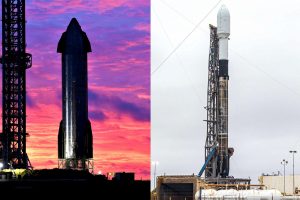SpaceX’s upgraded Starship booster has completed a second and third cryogenic proof test in rapid succession after undergoing repairs to fix damage suffered during the first round of testing.
Testing began almost immediately after SpaceX rolled the repaired Super Heavy booster back to the orbital launch site (OLS) on May 6th. After a quick installation on the pad’s stool-like launch mount and another day of systems checks and integration, Booster 7 charged headfirst into its first post-repair cryoproof on May 9th.
Instead of cautiously feeling out the repaired plumbing and header tank over a series of small tests, SpaceX immediately performed a full cryogenic proof (cryoproof) and filled Booster 7 to the brim with about 3000 tons (~6.6M lb) of liquid nitrogen (LN2) or a combination of LN2 and liquid oxygen (LOx). Standing about 67 meters (~220 ft) tall and 9 meters (~30 ft) wide, it took about two hours to fully fill Super Heavy’s tanks with the equivalent of one and a half Olympic swimming pools of cryogenic liquid.
As always, that liquid (well below –320°F or –196°C) rapidly chilled the booster’s 4mm (~0.16″) thick steel tanks to cryogenic temperatures, which then froze moisture directly out of the humid Texas air, coating almost all of Super Heavy’s exterior with a layer of frost and ice.

SpaceX began detanking Booster 7 soon after the fill process was completed. Thanks to plenty of insulated plumbing and well-insulated ground storage tanks, SpaceX is able to recover nearly all of the LN2 and LOx used during cryoproof testing, which helps avoid the hundreds of semi-truck delivers that would otherwise be required to replenish the tank farm after even a single test.
As if to demonstrate that, SpaceX proceeded to put Booster 7 through a whole new cryogenic proof test just two days later, on May 11th. Once again, Super Heavy was fully loaded with thousands of tons of liquid nitrogen and oxygen. Unlike Cryoproof #2’s immediate detank, SpaceX – judging by the frost levels – kept Booster 7 topped off for a good hour before detanking.
In a last-minute surprise, after fully detanking B7 at the end of Cryoproof #3, SpaceX refilled the booster’s liquid oxygen tank with a few hundred tons of LN2 or LOx. Once the rocket’s thrust section reached some degree of thermodynamic equilibrium, SpaceX remotely retracted and reconnected the orbital launch mount’s Super Heavy umbilical. The launch mount umbilical or ‘quick disconnect’ is responsible for connecting Super Heavy to the pad’s gas supplies, propellant storage, power, and communications. The test SpaceX completed after Cryoproof #3 may have been a rough simulation of one scenario Starship could easily face: a post-ignition launch abort. In other words, if an orbital Starship launch was aborted just before liftoff but after quick-disconnect retraction, could it quickly reconnect to the booster with zero human intervention?
In a scenario where a QD failed to reattach to a fully-fueled Super Heavy after a launch abort, the odds of a catastrophic fire or explosion would immediately shoot up to near-certainty. In moderate quantities, simultaneously venting gaseous methane and oxygen from the same rocket is risky but manageable. Venting hundreds – let alone thousands – of tons while trapped on the ground would amount to creating a multi-hour fuel-air bomb just waiting for a spark. Multiple Starship prototypes (SN4, SN10) have already been destroyed in part by the flammability of methane gas.

Combined with the completion of two full cryogenic proof tests in less than two days, it appears that Super Heavy B7’s repairs were extremely successful. Had the first post-repair cryoproof not gone more or less perfectly, it’s hard to imagine that SpaceX would have attempted or completed an almost identical test two days later. If the second cryoproof hadn’t been nearly perfect, it’s even harder to imagine that SpaceX would have accepted the risk involved in detaching Booster 7’s umbilical during the same test window.
On May 12th, SpaceX’s main pad crane attached a lift jig to Super Heavy B7, implying that it will likely be removed from the orbital launch mount in the near future. If the repaired booster aced its tests, SpaceX’s next step would likely be Raptor engine installation and the start of static fire testing. It’s unclear if SpaceX wants to install all 33 engines at once or begin with a small handful. It’s also unclear if SpaceX will return Booster 7 to Starbase’s production facilities to finish Raptor, heat shield, grid fin, and aerocover installation.





